European Neighbourhood Policy - East - statistics on science, technology and digital society
Data extracted in January 2023.
Planned article update: April 2024.
Highlights
Between 2011 and 2021 the mobile phone penetration rate increased by 28% in Georgia and by 73% in Moldova. In 2021, all the ENP-East countries had higher rates than in the EU.
Among the ENP-East countries, the share of households with access to a personal computer in 2021 was the highest in Azerbaijan (72%) and the lowest in Armenia (2020 data) at 58%, compared with 83% in the EU.
In 2021, Azerbaijan had the highest number of researchers per thousand inhabitants among the ENP-East countries, based on full-time equivalent units at 1.7. This compares with 4.5 in the EU.
Mobile phone penetration, 2011 and 2021
This article is part of an online publication; it presents information on five European Neighbourhood Policy-East (ENP-East) countries, namely, Armenia, Azerbaijan, Georgia, Moldova and Ukraine, compared with the European Union (EU). Georgia, Moldova and Ukraine also all became enlargement countries in 2022. The European Council gave the three a European perspective and granted Moldova and Ukraine candidate status on 23 June 2022. This article does not contain any data on Belarus, as statistical cooperation with Belarus has been suspended as of March 2022.
Data shown for Georgia exclude the regions of Abkhazia and South Ossetia over which Georgia does not exercise control. The data managed by the National Bureau of Statistics of the Republic of Moldova does not include data from Transnistria over which the government of the Republic of Moldova does not exercise control. Since 2014, data for Ukraine generally exclude the illegally annexed Autonomous Republic of Crimea and the City of Sevastopol and the territories which are not under control of the Ukrainian government. Data on Ukraine for the year 2021 is limited due to exemption under the martial law from mandatory data submission to the State Statistics Service of Ukraine, effective as of 3 March 2022. The latest statistics in this Statistics Explained article cover the calendar year 2021, before Russia's invasion of Ukraine.
The first part of this article provides details in relation to telecommunications and information and communications technology (ICT) usage: access to telephone services, mobile phone subscriptions and fixed telephone lines, households having access to a personal computer or the internet, and the use of the internet by enterprises.
The second part of the article gives an overview relating to research and development (R & D): the level of gross domestic expenditure on R & D (GERD), the ratio of R & D expenditure to gross domestic product (GDP) (which is also known as R & D intensity), and the number of R & D personnel and researchers.
Full article
Access to telephone services
There are more mobile telephone subscriptions than people in all ENP-East countries
Already by 2011 the number of mobile phone subscriptions in each of the ENP-East countries was higher than the number of inhabitants, indicating that a significant number of people had more than one mobile subscription. Despite this already high figure, the mobile telephone penetration rate — the number of subscriptions relative to the size of the population — continued to grow in all ENP-East countries over the period 2011-2021.
In 2011, Ukraine had a higher mobile telephone penetration rate than the other ENP-East countries, that had rates very similar to each other. Moldova's mobile telephone penetration rate grew by 73 % over 2011-2021, leading to the highest rate among ENP-East countries in 2021. Mobile telephone penetration also grew fairly rapidly in Georgia (28 %) and moderately in Armenia (14 %) over the period 2011-2021. From 2011, the mobile telephone penetration rate grew slowly in Azerbaijan to 2021 (4 %) and in Ukraine (5 %) (most recent data refer to 2018).
In general, reasons for multiple mobile phone subscriptions could include the following: separate subscriptions for work and personal use; different network coverage and quality between geographical areas; tourist temporary subscriptions; different pricing structures for data and voice use and for calls to own-network subscribers; and specific services, such as online banking, offered by some telephone service providers.
Most of these issues apply to a lesser extent in the EU, which accounts for the observation that all ENP-East countries had at least as high mobile telephone penetration as the EU in 2021. From the late 1980s and early 1990s, the number of subscriptions increased rapidly in the EU as mobile telephones became commonplace. In recent years, the mobile telephone penetration rate first stabilised and then declined in the EU, falling over the period 2011-2021 by an estimated -13 %.
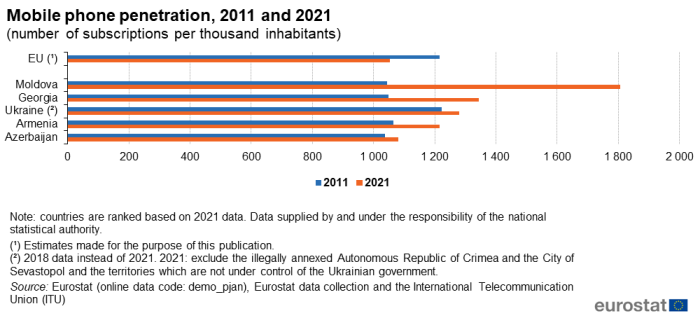
(number of subscriptions per thousand inhabitants)
Source: Eurostat (demo_pjan), Eurostat data collection and the International Telecommunication Union (ITU)
As mobile technology became widespread, the number of fixed telephone lines fell in the EU and in most of the ENP-East countries
Figure 2 presents information on the number of fixed telephone lines per thousand inhabitants. Fixed telephone lines connect a customer's equipment to the public switched telephone network (PSTN). This indicator, together with that of mobile telephony, is one of the broadest and most common measures used to evaluate the development of telecommunications.
In Georgia, Ukraine, Armenia and, to a lesser extent, Azerbaijan, the number of fixed telephone lines per thousand inhabitants fell between 2011 and 2021 (Ukraine data 2018) by 52 %, 46 %, 33 % and 8 %, respectively. No data is available for Moldova. Among the ENP-East countries in 2021, the number of fixed telephone lines per thousand inhabitants was by far the highest in Armenia, with 389 lines per thousand inhabitants. This was followed by Azerbaijan, with 148; Ukraine, 144 (2018 data); and Georgia, 76.
A potential reason for the decline in fixed telephone lines is likely to be their replacement by mobile telephone subscriptions by some customers. There may also be a reduction in the number of public telephones. A possible counteracting force may be an increase in the number of business fixed lines.
In the EU there were an estimated 355 fixed telephone lines per thousand inhabitants in 2021. This figure was 20 % below the penetration rate recorded in 2011.
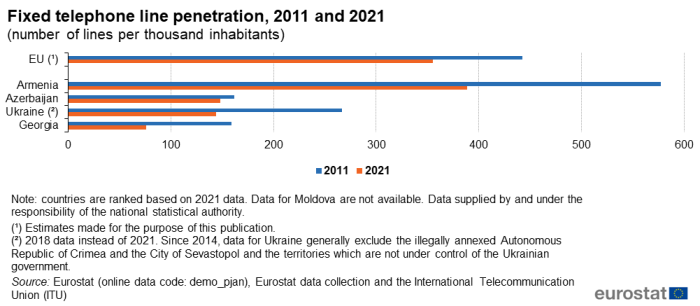
(number of lines per thousand inhabitants)
Source: Eurostat (demo_pjan), Eurostat data collection and the International Telecommunication Union
Access to a personal computer
Almost three-quarters of households in Azerbaijan have access to a personal computer
As shown in Figure 3, the proportion of households with access to a personal computer in 2021 was 72 % in Azerbaijan, the highest among the ENP-East countries. The other countries had similar rates of access to each other: Georgia (64 %), Moldova (61 %), Ukraine (61 %, 2020 data) and Armenia (58 %, 2020 data). For comparison, the proportion of households with access was 83 % in the EU in 2017 (no 2021 data).
The largest increase during the period 2011-2021 occurred in Georgia, where personal computer access increased by 36 percentage points (pp). The increase in Azerbaijan was 34 pp. In Moldova, there was an increase of 31 pp over the same period; in Armenia (to 2020), 29 pp; and in Ukraine (2012-2020), 16 pp. In 2012, Ukraine had a slightly higher rate of access to personal computers than other ENP-East countries, for which 2011 data is quoted. In the EU, personal computer access increased by 8 pp during the period 2011-2017.
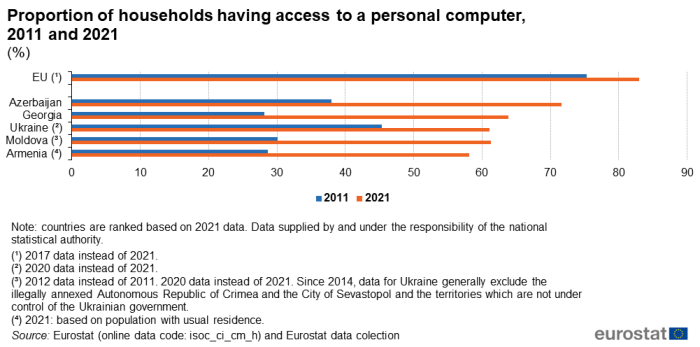
(%)
Source: Eurostat (isoc_ci_cm_h) and Eurostat data collection
Access to the internet at home
Widespread access to the internet at home via broadband is seen as essential for the development of advanced services on the internet, such as e-business, e-government or e-learning.
Four-fifths of households in Azerbaijan, Georgia and Ukraine had access to the internet at home in 2021
High levels of home access to the internet among the ENP-East countries in 2021 were recorded in Azerbaijan, at 87 %, Georgia, at 86 %, and Ukraine, at 83 %. Lower shares were recorded in Moldova, at 67 %, as well as in Armenia, 62 % (2020 data). This data is illustrated in Figure 4.
In recent years, all ENP-East countries recorded rapid increases in the proportion of households having home access to the internet. The largest access increase during the period 2011-2021 was recorded in Georgia at 60 pp. Over the same period, access in Ukraine increased by 56 pp, in Moldova by 42 pp, in Armenia (2011-2020) by 40 pp, and in Azerbaijan by 33 pp. Azerbaijan had the highest regional internet access rate in 2011 among ENP-East countries.
In the EU, the proportion of households with access to the internet at home was 92 % in 2021, having risen by 21 pp from 2011.
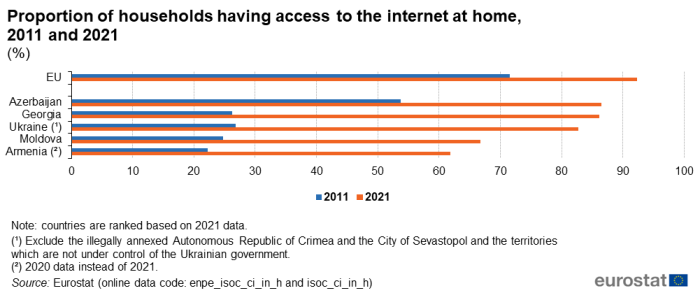
(%)
Source: Eurostat (enpe_isoc_ci_in_h) and (isoc_ci_in_h)
Azerbaijan had a notably lower proportion of enterprises that had access to the internet than other ENP-East countries
The data shown in Figure 5 represent the proportion of enterprises with 10 or more persons employed which had access to the internet in 2021, or in the most recent year for which data is available. High access proportions were reported in Georgia (95 %), Ukraine (87 %) and Moldova (87 %). A notably lower proportion, 66 %, was recorded for Azerbaijan. No data are available for Armenia. At 98 %, almost all EU enterprises had access to the internet in 2019.
Enterprise internet access improved during 2011-2021 by 5 pp in Azerbaijan. Access was marginally higher in Ukraine in 2021 compared with 2010. In the EU, the proportion of enterprises having access to the internet increased by 3 pp between 2011 and 2019.
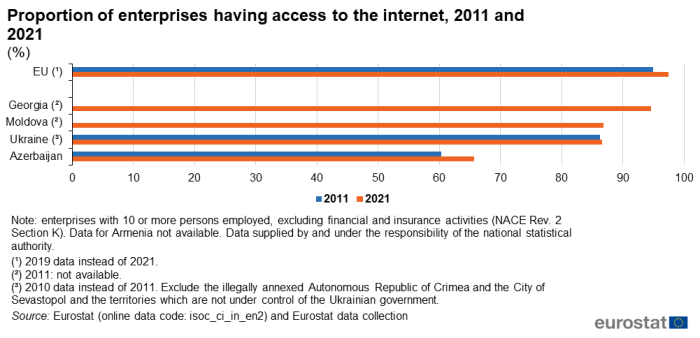
(%)
Source: Eurostat (isoc_ci_in_en2) and Eurostat data collection
Research and development expenditure
Research and development (R & D) consists of creative work undertaken on a systematic basis in order to increase the stock of knowledge, including knowledge of humanity, culture, science and society, and the use of this stock of knowledge to develop new applications.
In 2021, gross domestic expenditure on R & D in Ukraine was valued at €494 million, which was equivalent to 0.3 % (provisional data) of the country's GDP. This measure is known as R & D intensity. In Azerbaijan and Moldova, the other two ENP-East countries for which data are shown in Table 1 and Figure 6, R & D intensity was around 0.2 % in 2021. There is no recent data for Armenia and Georgia. In Ukraine, R & D intensity fell from 2011 to 2021 (note that there is a break in the data series), as well as in Moldova. R & D intensity was stable in Azerbaijan over the period 2011-2021.
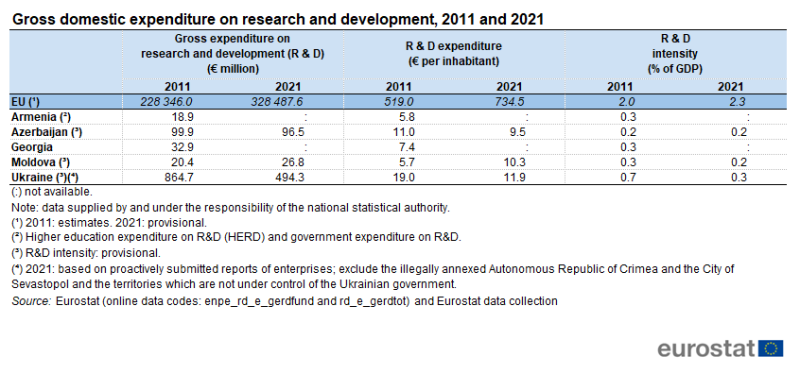
Source: Eurostat (enpe_rd_e_gerdfund) and (rd_e_gerdtot) and Eurostat data collection
R & D was valued at €328 billion in the EU in 2021 (provisional data), which was 44 % higher than ten years earlier (2011 data estimated). R & D intensity moved up in this period from 2.0 % to 2.3 % of GDP.
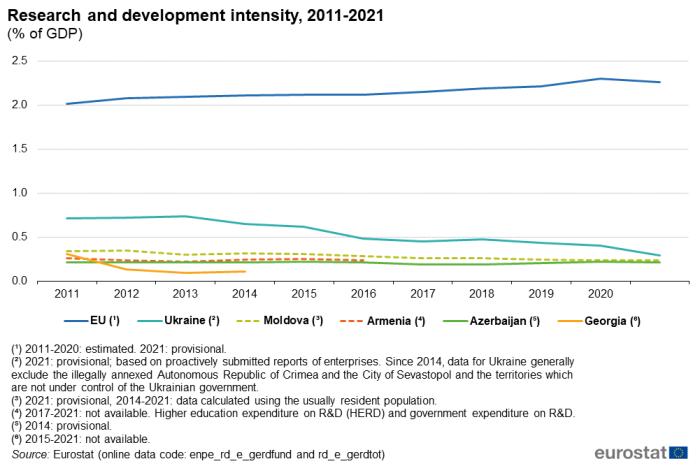
(% of GDP)
Source: Eurostat (enpe_rd_e_gerdfund) and (rd_e_gerdtot)
Research and development personnel and researchers
The total numbers of Research & development personnel and researchers (measured as full time equivalents) are shown in Table 2. The number of researchers per thousand inhabitants is shown in Figure 7. These are further measures of the incidence of research in a country.
Among the ENP-East countries, Ukraine reported the highest absolute numbers in 2021: 38 000 R & D personnel, among whom were 24 000 researchers. Azerbaijan, with 22 000 R&D personnel, including 17 000 researchers, had the second highest numbers. Armenia had 5 000 R&D personnel, including 4 000 researchers. Moldova had 3 000 R&D personnel, including 2 000 researchers. No data was available for Georgia.
Except Azerbaijan, the ENP-East countries that reported data showed fewer R & D personnel and fewer researchers in 2021 than they had in 2011. In Ukraine, the decline in both measures was -58 %. By contrast, in Azerbaijan the number of R & D personnel increased by 20 % and the number of researchers by 40 % from 2011 to 2021. In the EU, the number of R & D personnel is estimated to have increased by 35 % and the number of researchers by 41 % over the period 2011-2021.
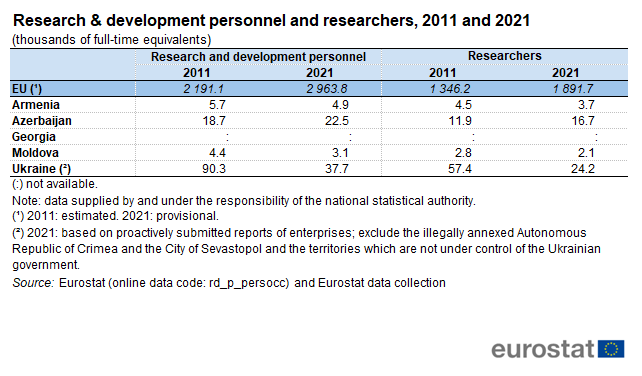
(thousands of full-time equivalents)
Source: Eurostat (rd_p_persocc) and Eurostat data collection
The highest ratio of researchers to the population as a whole in 2021 in the ENP-East countries was recorded in Azerbaijan, where there were 1.7 researchers per thousand inhabitants. In Armenia, the ratio was 1.3 and in Moldova, 0.8. This ratio was lowest in Ukraine, at 0.6 researchers per thousand inhabitants. In comparison, the EU had 4.5 researchers per thousand inhabitants in 2021 (provisional data).
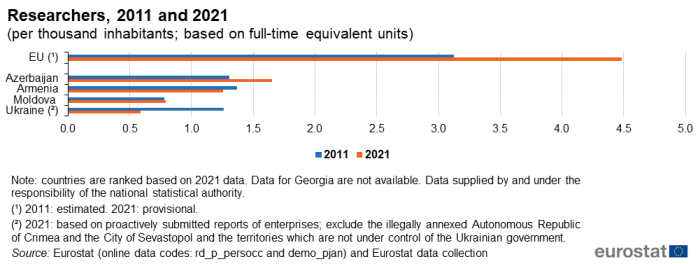
(per thousand inhabitants; based on full-time equivalent units)
Source: Eurostat (rd_p_persocc) and (demo_pjan) and Eurostat data collection
Source data for tables and graphs
Data sources
The data for ENP-East countries are supplied by and under the responsibility of the national statistical authorities of each country on a voluntary basis. The data result from an annual data collection cycle that has been established by Eurostat. These statistics are available free-of-charge on Eurostat's website, together with a range of additional indicators for ENP-East countries covering most socio-economic topics.
Information society
Eurostat's survey on ICT usage in households and by individuals is an annual survey used to benchmark ICT-driven developments. Eurostat's survey on ICT usage in enterprises is also an annual survey and generally covers enterprises with at least 10 persons employed. Note that the activity coverage excludes financial and insurance activities (NACE Rev. 2 Section K). These surveys follow developments of a set of core variables over time and provide greater depth for specific subjects through ad-hoc additional survey modules. While the surveys initially concentrated on access and connectivity issues, their scope has subsequently been extended to cover a range of subjects, for example, e-government, social media or e-commerce. Within the European statistical system, these two surveys are based on two methodological manuals: one for enterprise statistics and one for statistics related to households and individuals; these manuals are updated annually. The definitions which the ENP-East countries have been asked to follow when providing data are based on the methodology contained within these two manuals.
Internet access of households refers to the percentage of households that have an internet access, so that anyone in the household could use the internet at home, if so desired, even simply to send an e-mail.
Research and development
Eurostat data on research and development (R & D) aim to show a comprehensive picture of the situation in the EU, covering indicators related to expenditure and personnel. Most of the main indicators within this domain are available at national and regional levels for the EU Member States. The international standards for collecting and reporting data on research and experimental development are specified in the Frascati Manual. The definitions which the ENP countries have been asked to follow when providing data are based on the methodology contained within that manual.
Gross domestic expenditure on R & D (otherwise referred to as GERD) includes expenditure on R & D performed by business enterprises, higher education institutions, as well as government and private non-profit organisations. R & D expenditure by source of funds describes the origin of R & D funding. R & D intensity is defined as R & D expenditure relative to GDP (shown as a percentage).
R & D personnel consist of all individuals employed directly in the field of R & D, including persons providing direct services, such as managers, administrators and clerical staff.
Tables in this article use the following notation:
| Value in italics | data value is forecast, provisional or estimated and is therefore likely to change; |
| : | not available, confidential or unreliable value. |
Context
R & D is the main driver of innovation, with the level of R & D expenditure and the ratio of R & D intensity being two of the key indicators used to monitor resources devoted to science and technology.
On 2 July 2021, the European Commission and the EU High Representative for Foreign Affairs and Security Policy presented the Eastern Partnership: a Renewed Agenda for cooperation with the EU's Eastern partners. This agenda is based on the five long-term objectives, with resilience at its core, as defined for the future of the Eastern Partnership in the Joint Communication Eastern Partnership policy beyond 2020: Reinforcing Resilience – an Eastern Partnership that delivers for all in March 2020. It is further elaborated in the Joint Staff Working Document Recovery, resilience and reform: post 2020 Eastern Partnership priorities. It will be underpinned by an Economic and Investment plan. The Joint Declaration of the Eastern Partnership Summit 'Recovery, Resilience and Reform' of 15 December 2021 reaffirms strong commitment to a strategic, ambitious and forward-looking Eastern Partnership.
In cooperation with its ENP partners, Eurostat has the responsibility 'to promote and implement the use of European and internationally recognised standards and methodology for the production of statistics, necessary for developing and monitoring policy achievements in all policy areas'. Eurostat undertakes the task of coordinating EU efforts to increase the statistical capacity of the ENP countries. Additional information on the policy context of the ENP is provided here.
Direct access to
- All articles on non-EU countries
- European Neighbourhood Policy countries — statistical overview — online publication
- Statistical cooperation — online publication
- All articles on science and technology
Books
Factsheets
Leaflets
- Basic figures on the European Neighbourhood Policy — East countries — 2020 edition
- Basic figures on the European Neighbourhood Policy — East countries — 2020 edition
- Basic figures on the European Neighbourhood Policy — East countries — 2019 edition
- Basic figures on the European Neighbourhood Policy — East countries — 2018 edition
- Basic figures on the European Neighbourhood Policy — East countries — 2016 edition
- Basic figures on the European Neighbourhood Policy — East countries — 2015 edition
- Basic figures on the European Neighbourhood Policy — East countries — 2014 edition
- Research and development, digital society (enpe_sci)
- R&D expenditure (enpe_rd)
- Digital society (enpe_isoc)
- Research and development, digital society (enpe_sci)
- ICT usage in households and by individuals (isoc_i)
- ICT usage in enterprises (isoc_e)
- Research and development (R&D) (rd)
- Eastern European Neighbourhood Policy countries (ENP-East) (ESMS metadata file — enpe_esms)
- European External Action Service — European Neighbourhood Policy
- Joint Communication JOIN(2020) 7 final: Eastern Partnership policy beyond 2020: Reinforcing Resilience - an Eastern Partnership that delivers for all (18 March 2020)
- Joint Staff Working Document SWD(2021) 186 final: Recovery, resilience and reform: post 2020 Eastern Partnership priorities (2 July 2021)
- Joint Declaration of the Eastern Partnership Summit: 'Recovery, Resilience and Reform' (15 December 2021)
- European Commission — Digital single market
- European Commission — Communications Networks, Content and Technology
- European Commission — Horizon 2020
- European Commission — Joint Research Centre (JRC) — the EU industrial R&D investment scoreboard
- European Commission — Research and Innovation